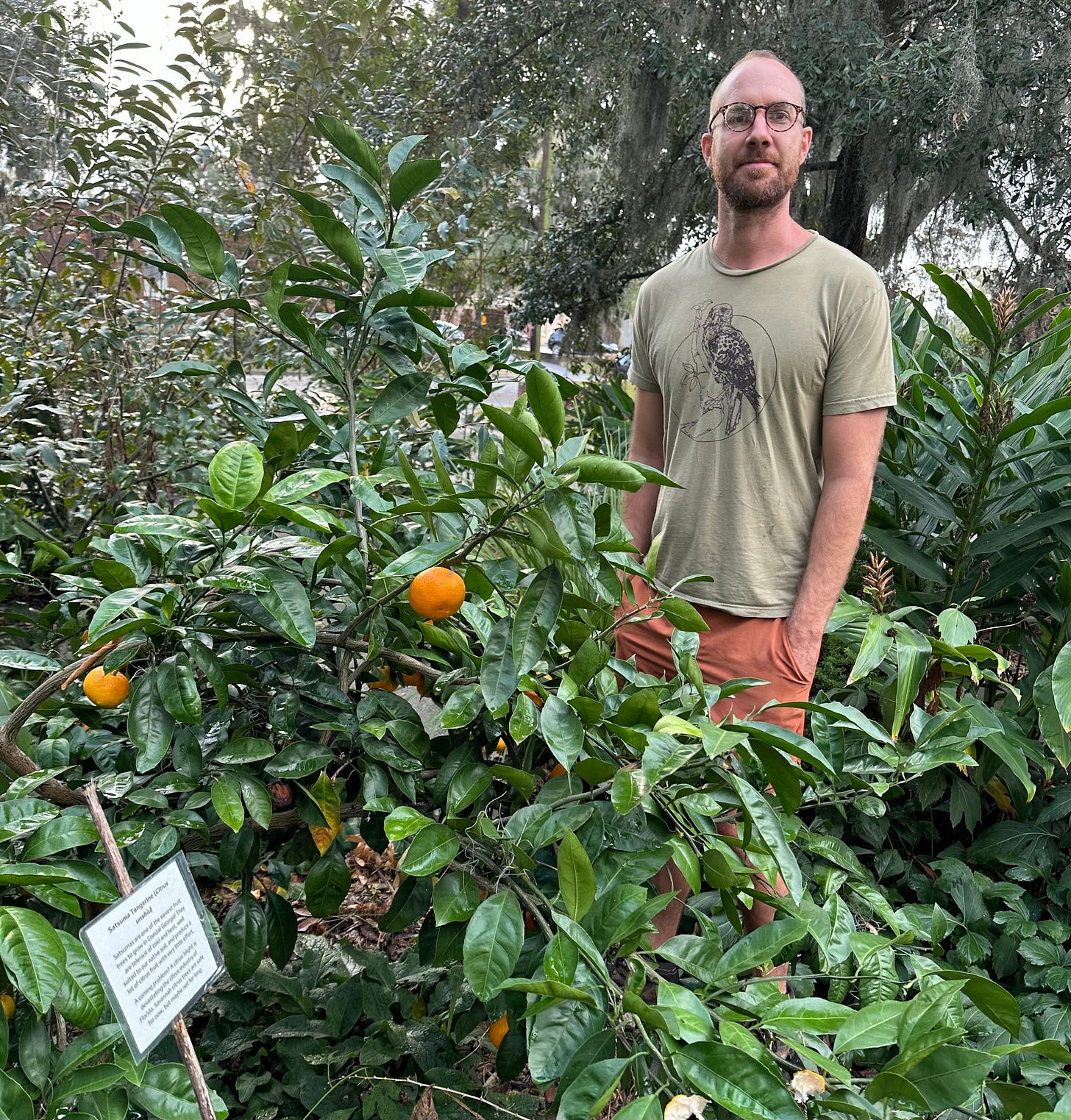Lessons from the Paw Paw Patch
Somewhere on the east side of town, in a neighborhood you’ve never heard of, lies an oasis hidden in plain sight.
Banana trees burst with fruit, pumpkin vines sprawl near the sidewalk, a butternut squash the size of football lounges two feet from the curb. The pineapple guavas and avocados came and went with the heat, but the ripening persimmons and little apple-like globes called jujubes flaunt their fall hues in the front yard. Several massive oaks oversee the thicket like bemused aunties, stretching the moss-draped fingers of their branches as a doting shield.
“Something is ready to eat pretty much all year long,” says Ben Chaffee, the lanky, laidback architect behind this perennial paradise, handing me a banana with the girth of a beer can.
“At this point all we do is harvest.”
I’m astonished at the ensconced bounty, having driven past the small cottage with its tangled wall of green a thousand times, figuring the place was inhabited by a family of gnomes with a broken lawnmower.
Close-up and slowed down, however, it’s obvious this streetside jungle is tended with loving, intentional hands. The plan for it to yield for decades to come is ambitious—audacious even. Yet it may be one of the smartest, simplest models for our safety, sanity, and survival.
When Ben and partner Alex Zinn bought the property from Alex’s folks a decade ago, it had lain mostly fallow for years. But the triple lot afforded plenty of space for experimentation, and Ben renewed his childhood hobby of propagating plants to research and cultivate ways to grow and share food with their friends and neighbors.
“There are three levels to an urban food forest,” explains Ben, offering a quick lesson in agroecology, the development of sustainable food systems that maximize production with minimal maintenance.
“There’s the oak canopy, which was already established, then there’s the understory—that’s the fruit trees, we planted most of them four or five years ago—and then the groundcover.”
The whole arrangement requires no weeding or watering—a horticultural style Ben refers to as “non-management,” reminding me of my un-mentor and reluctant sage Jane Fishman, who wrote an entire book about gardening by neglect.
I miss Jane a lot. I keep thinking about her as I walk amongst the monarch butterflies and pollen-dusted bees bouncing around the vines and shrubs. Maybe she could help make sense of things right now; we could all use a dose of her irascible wisdom. She would've delighted in this wild, generous place, especially what Ben shows me next.
He leads me past the driveway blanketed on each side by crisp “longevity spinach”—a tasty green popular in Southeast Asia that fares better in our southern climate than its fragile cousin—to the inner sanctum, the most treasured section of the understory: A cluster of pawpaw trees near the brick firepit.
Native to the Southeast and revered by the region’s indigenous ancestors, these slow-growing dwarves grow in clumps and yield fist-sized, custardy fruits all too rare in modern yards and gardens. Culinary sleuth and my main mensch Michael Twitty has documented the pawpaw’s presence among enslaved people’s homes and along the Underground Railroad, and during the Great Depression its nickname was the “poor man’s banana.” Yet North America’s largest tree-grown delectable remains mostly unknown and underappreciated.
“They were eaten in this area for centuries, but they bruise too easily to be exported, so people just kind of forgot about them,” shrugs Ben, recounting the historic amnesia of the pawpaw.
“They’re so delicious.”
I’ll have to wait until next summer to find out, but pawpaws reportedly taste like a tropical trifecta of banana, mango, and pineapple—now that sounds like a palate party. Can’t wait for my man to add them to his redfish and chanterelle bonanzas!
Apparently there’s an abundance of pawpaw trees around town if you know where to look, which begs the question: Why haven’t Savannah chefs seized upon this foragable fortune? When do we start seeing menus listing pawpaw pasta and paw-paw pie? (Speaking of culinary innovation, there is a direct relationship between Ben and Alex’s Paw Paw Patch and the origin of Sixby, but you’ll have to stop in and ask Natasha.)
The plush patch has more purpose than its edible yield. Like Jane, who loved for people to wander around her unruly gardens and remember their own wildness, these green-thumbed gents understand their hidden haven to be a seeding ground not just of plants and food, but of community.
“We tend to see ourselves as outside of nature, yet we are nature,” implores Ben, pointing to our diversity and adaptability.
“And the way we interact with each other is part of our environment—culture is an ecological concept.”
To that end, the Paw Paw Patch often hosts offbeat, loosely-organized happenings, from beekeeping workshops to queer dance parties, offering a chance to dispel what Ben calls “a pandemic of loneliness.”
“It can be hard, especially in LGBT circles, to find places that don’t cost money or center around alcohol,” he muses, adding that social media with its self-segregating platforms is a poor substitute for in-person connection.
“We need spaces where we can experiment, that include all kinds of people, from multiple generations.”
Keep reading with a 7-day free trial
Subscribe to Savannah Sideways to keep reading this post and get 7 days of free access to the full post archives.


